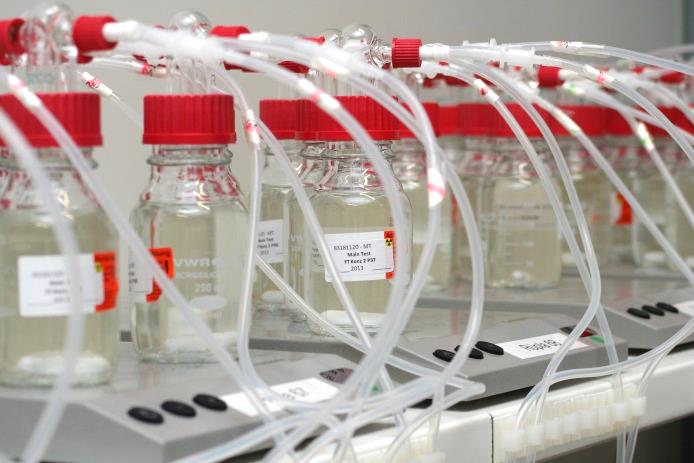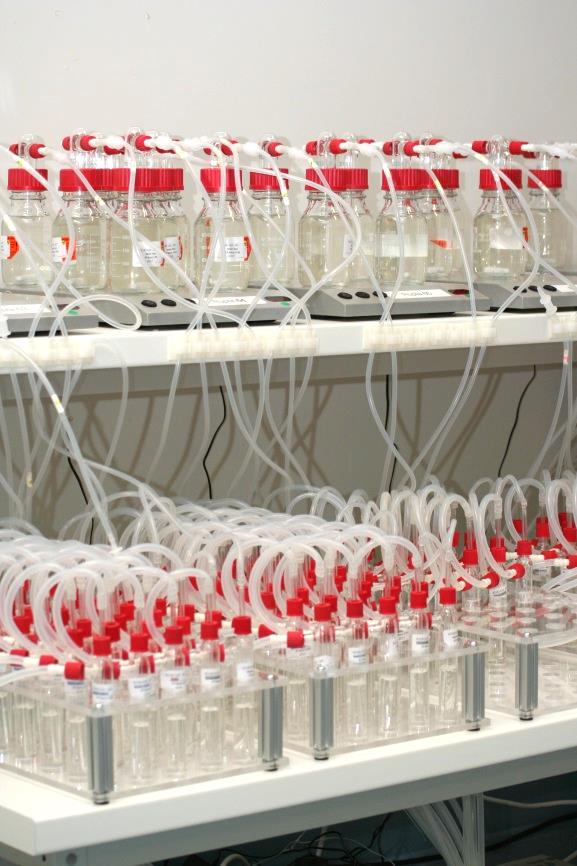- Your Product Type
- Your Study Type
- Aquatic Ecotoxicology
- Aquatic Invertebrates
- OECD 202: Daphnia sp., Acute Immobilisation Test
- OECD 211: Daphnia magna Reproduction Test
- OECD 235: Chironomus sp., Acute Immobilisation Test
- OECD 218/219: Sediment-Water Chironomid Toxicity Test Using Spiked Sediment/Spiked Water
- OECD 233: Sediment-Water Chironomid Life-Cycle Toxicity Test Using Spiked Water or Spiked Sediment
- OECD 225: Sediment-water Lumbriculus Toxicity Test Using Spiked Sediment
- OECD 242: Potamopyrgus antipodarum Reproduction Test
- OECD 243: Lymnaea stagnalis Reproduction Test
- Fish and other vertebrates
- OECD 203: Fish, Acute Toxicity Test
- OECD 215: Fish Juvenile Growth Study
- OECD 212: Fish, Short-term Toxicity Test on Embryo and Sac-fry Stages
- OECD 231: The Amphibian Metamorphosis Assay
- OECD 236: Fish Embryo Acute Toxicity Test
- OECD 210: Fish, Early-life Stage Toxicity Test
- OECD 229 Fish Short Term Reproduction Assay and OECD 230 21-day Fish Assay
- OECD 240 Medaka Extended One Generation Reproduction Test (MEOGRT)
- OECD 248: Xenopus Eleutheroembryonic Thyroid Assay
- OPPTS 850.1500: Fish Life Cycle Toxicity Test
- OÈCD 234 Fish sexual development test
- Aquatic plants
- Analytical Dose Verification
- Aquatic Invertebrates
- Chemistry
- Biodegradation Studies
- Analytical Chemistry Studies and Residues
- Physical-Chemical Properties Studies
- Storage Stability Studies
- OPPTS 830.6302, OPPTS 830.6303,and OPPTS 830.6304: Physical State, Colour and Odor at 20 °C and at 101.3 kPa
- EU A.1: Melting temperature/range
- EU A.2: Boiling temperature
- EU A.3: Relative density (liquids and solids)
- EU A.4: Vapour pressure
- EU A.5: Surface tension
- EU A.9: Flashpoint
- EU A.10: Flammability (solids)
- EU A.12: Flammability (contact with water)
- EU A.13: Pyrophoric properties of solids and liquids
- EU A.16: Relative self-ignition temperature for solids
- EU A.17: Oxidising properties
- OECD 114: Viscosity of Liquids
- Environmental Fate
- Transformation in Soil
- Transformation in Water
- Transformation in Manure
- Adsorption on Soil and Sewage Sludge
- Bioaccumulation and Bioconcentration
- Terrestrial Ecotoxicology
- Non-target Arthropods
- Non-target arthropod testing with the parasitic wasp (Aphidius rhopalosiphi)
- Non-target arthropod testing with the lacewing (Chrysoperla carnea)
- Non-target arthropod testing with the ladybird beetle (Coccinella septempunctata)
- Non-target arthropod testing with the predatory bug (Orius laevigatus)
- Non-target arthropod testing with the predatory mite (Typhlodromus pyri)
- Non-target arthropod testing with the rove beetle (Aleochara bilineata)
- Non-target arthropod testing with the carabid beetle (Poecilus cupreus)
- Non-target arthropod testing with the wolf spider (Pardosa spec.)
- Soil Organisms
- Honey Bees and other Pollinators
- OECD 213/214: Honey bees, Acute Oral and Acute Contact Toxicity Test
- OECD 245: Honey Bee (Apis Mellifera L.), Chronic Oral Toxicity Test (10-Day Feeding)
- OECD 237: Honey Bee Larval Toxicity Test, Single Exposure
- OECD 239: Honey Bee Larval Toxicity Test
- EPPO 170: Honey Bee Field Study – do plant protection products effect honey bee colonies?
- Oomen et al. 1992: Honey Bee Brood Feeding Study
- OECD 75: Honey Bee Brood Test under Semi-field Conditions in Tunnels
- OECD 246/247 Acute Oral and Contact Toxicity to the Bumblebee, Bombus terrestris L.
- Solitary Bee Acute Contact Toxicity Study in the Laboratory (Osmia sp.) Solitary Bee Acute Oral Toxicity Study in the Laboratory (Osmia sp.) (protocols for ringtests with solitary bees recommended by the non-Apis working group)
- SANTE/11956/2016 rev.9 Residue trials for MRL setting in honey
- Non-target plants
- OECD 208: Terrestrial Plant Test - Seedling Emergence and Seedling Growth Test
- OECD 227: Terrestrial Plant Test - Vegetative Vigour Test
- OCSPP 850.4100: Seedling Emergence and Seedling Growth
- OCSPP 850.4150: Vegetative Vigor
- EPPO PP 1/207(2): Efficacy evaluation of plant protection products, Effects on succeeding crops
- Field Studies
- Non-target Arthropods
- Ecological Modelling
- Quality Assurance
- Testing of Potential Endocrine Disruptors
- Aquatic Ecotoxicology
- News
- Company
- Career
- Contact
OECD 309: Aerobic Mineralisation in Surface Water – Simulation Biodegradation Test
The purpose of this test is to measure the time course of biodegradation of a test substance at low concentration in aerobic natural water and to quantify the observations in the form of kinetic rate expressions. Degradation of the test substance will be followed for the parent substance and its potential (known) transformation products. Degradation rate, mass balancing and transformation product pattern will be determined for the test substance. Degradation kinetics will also be followed for any major transformation product, if possible.
Study Design
Test setup
Typically, the test will be carried out with 14C-labelled test substance. Incubation in surface water (“pelagic test”) will be accomplished in the dark at a temperature of 20°C under aerobic conditions and agitation (stirring). The test will be conducted using multiple flask design where each flask is connected to a flow-through system. A moderate stream of air will be used as carrier gas to collect CO2 and other volatiles in distinct traps consisting of different solutions.

Course of the test
Two concentrations of the test substance differing by a factor of 5 to 10 will be used for the test. One concentration will be ≤ 10 μg/L (concentration I) and one ≤ 100 μg/L (concentration II).
Microbial activity of the surface water will be verified by using 14C-labelled benzoic acid (control samples). For examining possible abiotic degradation or other non-biological removal of the test substance (e.g. hydrolysis or adsorption to the test vessel), sterile samples will be prepared.
The test will run for a maximum of 60 days. Apart from samples taken directly after application, at least 7 sampling time points will be included. Time intervals will be chosen in such a way that the pattern of decline of the test substance and possible transformation products can be established.
Analysis of the test substance and transformation products
In case of the 14C-labelled test substance the analytical methods will base on LSC and HPLC coupled with UV and radio detection. LC-MS/MS can be carried out as additional analytical method. The analytical method and sample preparation will be established to allow a limit of quantification of ≤ 5% of the applied radioactivity.
Special test setup
- Non-labelled test substance can also be used for the test to investigate the degradation kinetics (e.g. DT50) of the test substance.
- In order to provide a minimum of mineral and nutrient source for the microbial population, a small concentration of suspended solids, in the form of sediment, can be added to the surface water (≤ 0.01 g/L).
- In general, the test samples will be agitated by stirring. Depending on the costumer needs, a setup for shaking the test samples is also available.

Endpoints
Kinetic analysis and calculations of DT50 and DT90 values
Transformation product pattern including characterisation/ identification of major products.
Guidelines and Literature
- OECD Guideline for the Testing of Chemicals, No. 309, ”Aerobic Mineralisation in Surface Water – Simulation Biodegradation Test”; adopted April 13, 2004.
